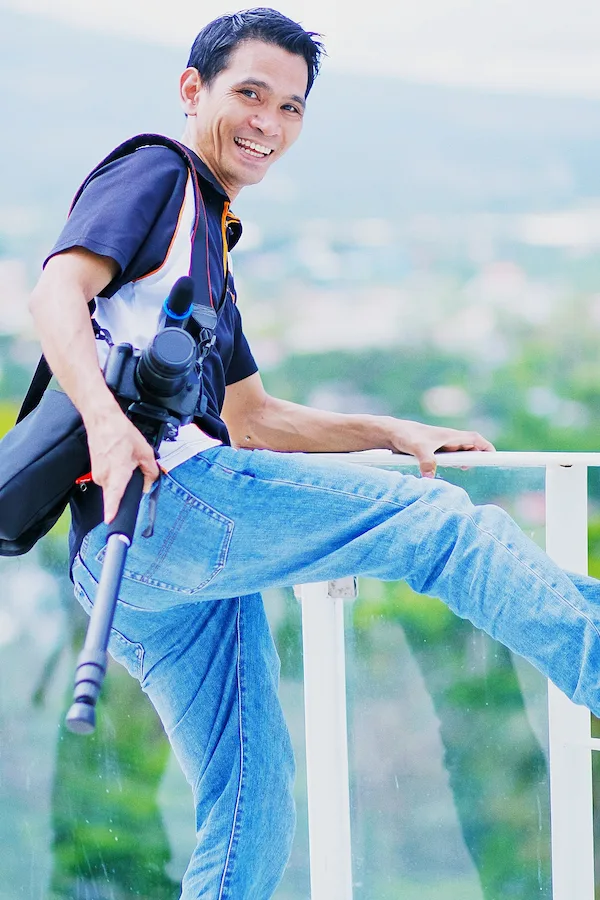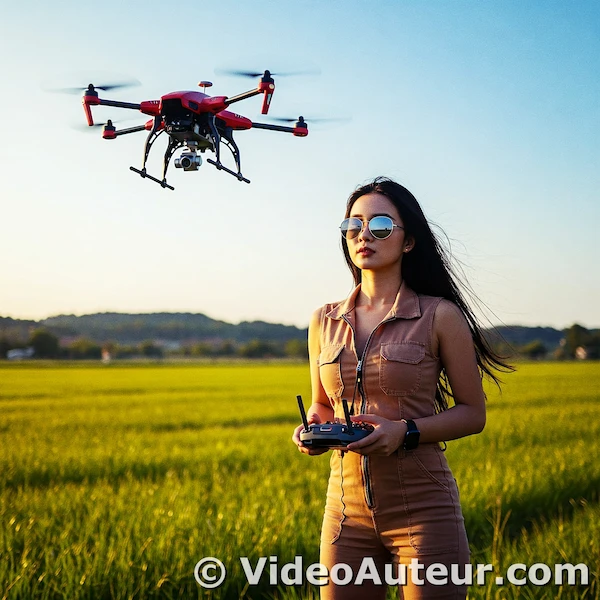- Video Production
- Video Making Tips for Beginners
- How to become a videographer
- How do I move up from Production Assistant
How Do I Move Up from Production Assistant? 5 Career-Changing Pathways
"So, how do I move up from Production Assistant?" you ask, as you find yourself handing over yet another crucial piece of gear, watching the real action unfold.
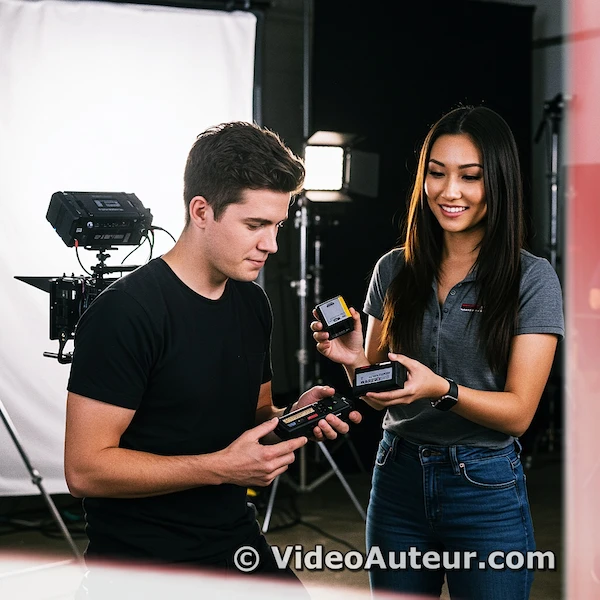
Imagine this: You’re at a wedding, holding a spare battery for the videographer. The bride’s father wipes away tears as she walks down the aisle—a fleeting moment the main camera misses. You whisper to the shooter, but inside, you’re thinking, “What if I could capture that myself?”
This is how many careers in video production begin. As a production assistant (PA), you’re in the heart of the action: running cables, organizing gear, and quietly observing the story unfold. You feel the buzz of the set—the lights, the sound, the energy—and think, “I want to create that.”
You’re itching to step out of the shadows, to move from supporting roles to shaping stories yourself. But how?
The truth is, moving up takes more than just skill. It’s about patience, mindset, and knowing the invisible steps nobody talks about.
Maybe you’ve wondered: Do I wait for someone to notice my hard work? Do I need more training? How do I prove I’m ready?
Here's the thing...
You already have something priceless: insight. You’ve seen how sets run, how problems get solved, and how moments turn into meaning. Now it’s about turning that behind-the-scenes knowledge into your storytelling toolkit.
But this journey isn’t about luck or shortcuts. It’s about strategy, learning, and a quiet kind of persistence—the kind that turns “What if?” into “I can.” Let’s walk through it together, step by step.
Key Takeaways - "How do I move up from Production Assistant?"
- Leverage Your PA Role as a Stealth Apprenticeship: Observe workflows, problem-solving, and storytelling techniques on set to build foundational knowledge.
- Proactive Learning & Initiative: Suggest ideas, ask to shadow crew members, and practice skills during downtime (for example, filming B-roll or organizing footage).
- Master Underrated Skills: Prioritize sound design, client communication, and file organization to stand out as a reliable collaborator.
- Explore Diverse Career Paths: Transition into roles like Second Shooter, Editor, Drone Operator, or Production Coordinator based on your interests and strengths.
- Build a Portfolio with Minimal Resources: Use smartphones, free editing tools, and volunteer projects to create work samples. Focus on storytelling over gear.
- Network Strategically: Turn PA gigs into learning opportunities by asking questions, offering help, and joining niche communities for mentorship.
- Develop “Invisible” Human Skills: Efficiency, problem-solving (“I’ll figure it out”), and emotional intelligence (translating client needs into actionable plans) are critical for advancement.
- Start Small, Iterate Often: Film daily moments, re-edit existing footage, and embrace imperfection to build confidence and technical proficiency.
- Reinvest Early Wins: Use earnings from side gigs to upgrade tools or skills, prioritizing low-cost investments like lens rentals or online courses.
- Speak Up About Goals: Casually express interest in learning specific roles or tasks to supervisors—for example, “I’d love to help with lighting setup next time.”
This section is a guest post from one of our web visitors...
A Production Assistant’s Journey to Learning Video Making
By Jessica (Philippines)
Hi, I’m Jessica.
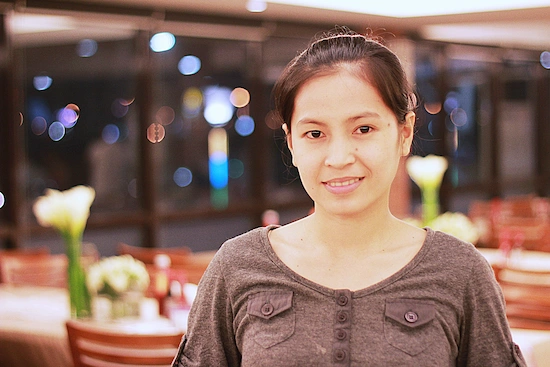 "How do I move up from Production Assistant?"
"How do I move up from Production Assistant?"As a production assistant, I occasionally assist a team of event shooters, and what I see during video shoots makes me want to learn how to create videos myself.

The team I work with covers weddings, birthdays, debut parties, corporate events—and even funerals. My main job is to support the videographer by ensuring their camera bags and equipment are safe, setting up portable lighting, charging batteries, and handling other tasks.
Sometimes, while working, I see special moments I wish I could capture—emotions and reactions from angles that the main videographer and photographers might miss. I even point out these moments to the videographer, who kindly considers my suggestions.

This has made me realize that I don’t just want to assist—I want to shoot videos myself.
I understand that video shooting isn’t just about pressing the record button. There are techniques and perspectives that bring a story to life. But before I can start filming, I need a camera that fits my budget—nothing fancy yet!
For now, I’m still learning, and honestly, I still feel a bit nervous. But I believe that with practice, I’ll grow more confident. I’d love to start as a second shooter, capturing different angles and moments that complement the main footage.
Jessica's experience demonstrates how observation and initiative can fuel personal growth. Her story highlights the importance of:
- Observation: Paying attention to the techniques and approaches of experienced shooters.
- Proactive Learning: Seeking opportunities to learn and practice.
- Initiative: Taking the initiative to suggest ideas and solutions.
- Building Confidence: Overcoming nerves and developing self-assurance.
What Comes After Production Assistant?
The PA role isn’t a holding pattern—it’s a launchpad. Your time on set has given you a front-row seat to the chaos and creativity of video production.
Now, it’s about choosing your next step. The beauty? There’s no single “right” path. Your future depends on what excites you: Do you want to...
- command the camera,
- shape stories in the edit bay, or
- orchestrate the entire production?
Let’s break down the possibilities.
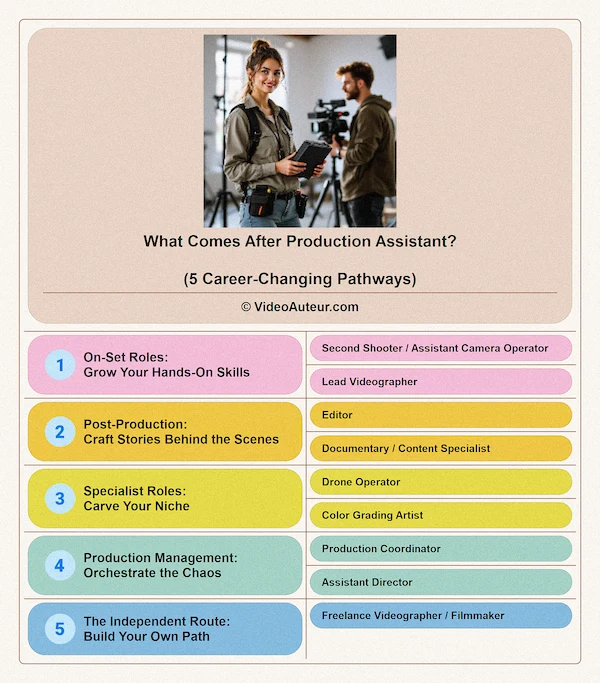 "How do I move up from Production Assistant? What is the next step up from Production Assistant?"
"How do I move up from Production Assistant? What is the next step up from Production Assistant?"1. On-Set Roles: Grow Your Hands-On Skills
Second Shooter / Assistant Camera Operator
What it involves: Capture B-roll, alternate angles, or candid moments while supporting the lead videographer. Think of it as training wheels for bigger shoots.
How to get here: Build trust by nailing small tasks first. During downtime, ask to film secondary shots (“Can I grab close-ups of the rings while you focus on the couple?”).
Lead Videographer
What it involves: Oversee entire shoots, from directing clients to editing final cuts.
How to get here: Master three underrated skills:
- Sound design: Bad audio distracts more than blurry footage. (I'd rather watch a lo-fi video with clear sound, than to struggle understanding a highly-polished video with bad audio.) Practice mic placement and noise reduction.
- Client communication: Learn to translate vague requests (“Make it cinematic”) into actionable plans by asking questions like, “What emotions do you want the audience to feel?” (A question like this is so important because it's about the emotional connection your video can make with the viewers.)
- File organization: Name files clearly, back up footage religiously, and save future-you from panic.
2. Post-Production: Craft Stories Behind the Scenes
Editor
What it involves: The editing process transforms raw footage by harmonizing pacing, music, and emotion to tell a polished story.
How to get here: Practice with free tools like DaVinci Resolve. Re-edit footage from shoots you’ve worked on (with permission!) to build a portfolio.
Documentary / Content Specialist
What it involves: Focus on niches like documentary storytelling, social media clips, or corporate videos.
How to get here: Study your favorite creators. What makes their work unique? Mimic their techniques, then add your voice and point of view.
3. Specialist Roles: Carve Your Niche
Drone Operator
What it involves: Capture sweeping aerial shots that elevate productions.
How to get here: Get certified and practice flying in open spaces—without crashing into trees. Follow drone laws and regulations in your country.
Color Grading Artist
What it involves: Set the mood of a video through color correction and stylized tones.
How to get here: Dive into software like DaVinci Resolve or Adobe Premiere. Analyze films you love: Are their tones warm and nostalgic? Cool and tense?
4. Production Management: Orchestrate the Chaos
Production Coordinator
What it involves: Manage schedules, budgets, and logistics. You’re the glue holding the shoot together.
How to get here: Offer to help with call sheets or equipment tracking as a PA. Show you can handle details without dropping the ball.
Assistant Director
What it involves: Keep the shoot on schedule, wrangle talent, and problem-solve fires (literal or metaphorical).
How to get here: Observe how directors work. Practice delegating tasks calmly—even when things go sideways.
5. The Independent Route: Build Your Own Path
Freelance Videographer / Filmmaker
What it involves: Run your own gigs, from weddings to passion projects.
How to get here: Start small. Film a friend’s hobby project for free (or cheap) to build a reel. Use your PA network to find clients—they already know you’re reliable.
The Key to Moving Up? Lean Into Your Curiosity
There’s no “promotion” waiting for you—you create it. Volunteer to help the editor organize footage. Ask the drone operator about their setup. Shadow the producer during scheduling calls.
Every role you see on set is within reach, but it starts with treating your PA gig as a paid education.
Your next job won’t land in your lap. It’ll come from...
- the relationships you nurture,
- the skills you practice in stolen moments, and
- the quiet confidence to say, “I can try that.”
So, what’s after PA? Whatever you’re brave enough to pursue. :-)
How to Start Video Making for Beginners (When You’re Broke)
Let’s get one thing straight: You don’t need fancy gear to begin telling stories with video. Some of the most compelling work starts with a phone, curiosity, and a willingness to learn.
If you’re a PA dreaming of moving into shooting or editing, here’s how to build your skills—even if your budget is $0.
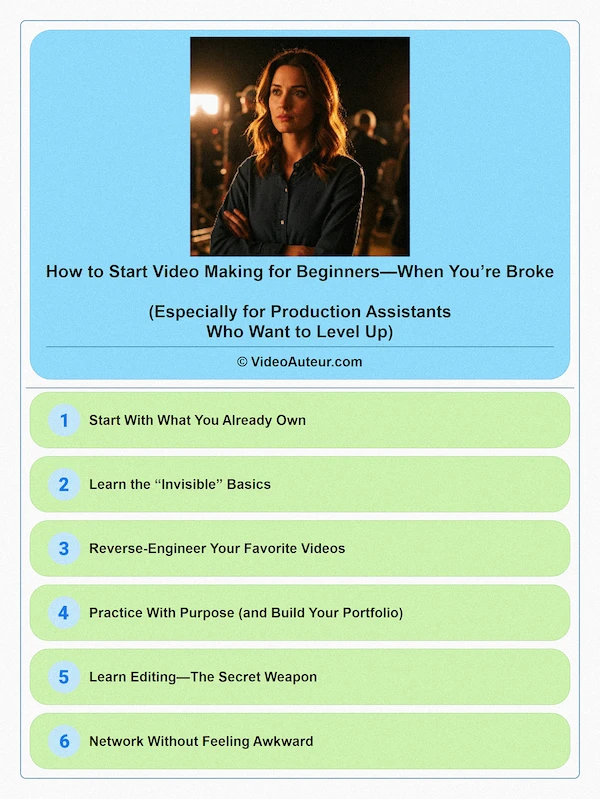 "How do I move up from Production Assistant? How do I start my video making journey when I'm a broke PA?"
"How do I move up from Production Assistant? How do I start my video making journey when I'm a broke PA?"1. Start With What You Already Own
Your smartphone is a powerhouse. Modern phones shoot in 4K (though 1080p is perfectly fine).
Use free apps, like—Filmic Pro or Moment—for manual controls over focus and exposure. No apps? Just hit record—your goal is to practice seeing the world through a storyteller’s lens.
DIY Gear Hacks:
- Steady shots without a gimbal: Tuck your elbows into your sides, hold your breath gently, and move slowly.
- Lighting on a dime: Face subjects toward a window for soft, flattering light. Use a white bedsheet as a reflector or a lamp with a paper towel taped over it to diffuse harsh bulbs.
- Sound hacks: Record voiceovers under a blanket to muffle background noise.
2. Learn the “Invisible” Basics
Master these fundamentals, and your work will look pro—even on a phone:
- The 5–10 second rule: Film each clip for 5–10 seconds to ensure you capture usable moments (editors love this!). For example, shoot a wide shot of a room for 10 seconds, then a close-up of a subject’s hands for 5.
- Composition: Use the “rule of thirds” (position subjects off-center) and “leading lines” (use sidewalks, fences, or shadows to guide the viewer’s eye).
- Lighting: Observe how sunlight changes throughout the day. Golden hour (sunrise/sunset) is your best friend for cinematic warmth.
3. Reverse-Engineer Your Favorite Videos
Watch like a filmmaker, not a viewer. Pick a scene from a movie, YouTube video, or commercial you admire and ask:
- What shot types are used? (Wide, medium, close-up?)
- How does the camera move? (Static, panning, tracking?)
- Where is the light coming from? Is the mood warm or cool?
- What sounds do you hear? (Dialogue, ambient noise, music?)
Then, recreate it with what you have. Film a friend walking into a room, mimicking the lighting and angles. You’ll learn faster by doing than by watching tutorials. Really!
4. Practice With Purpose (and Build Your Portfolio)
Volunteer your skills:
- Offer to film a local animal shelter’s adoptable pets.
- Document a friend’s hobby (baking, painting, skateboarding) into a 1-minute “day in the life” video.
- Help a community theater group record their rehearsals.
Pro tip: Edit these projects into a portfolio, even if they’re rough. Use free tools like DaVinci Resolve, Clipchamp, or iMovie—they’re more powerful than you think.
5. Learn Editing—The Secret Weapon
Editing is where your footage becomes a story. Start simple:
- Cut on action (e.g., start a clip as someone begins to smile, end it as the smile fades).
- Use YouTube Audio Library or royalty-free music sites.
- Add subtle transitions (a fade to black can feel more polished than a flashy effect).
Try this challenge: Re-edit a scene from a shoot you worked on as a PA (ask permission first!). Notice how pacing changes the emotion.
6. Network Without Feeling Awkward
Turn your PA gigs into classrooms:
- Ask the camera crew: “Can I try framing this shot while you’re setting up lights?”
- Shadow the editor during lunch breaks: “How do you decide where to cut a scene?”
- Offer to organize footage for a freelancer in exchange for feedback on your work.
Remember: Growth is more valuable than flawless execution.
Your first videos might feel shaky or disjointed—that’s normal.
Many videographers start by filming anything they can—friend’s hobbies, local events, even their cat’s antics—using whatever camera they could borrow or already owned. Over time, they built a portfolio through those scrappy early projects, landed bigger gigs, and reinvested earnings into better gear.
Your first videos won’t be perfect, but they’ll teach you how to find light, frame shots, and turn chaos into story. Start where you are.
The key? Consistency, not gear. Film something every week, even if it’s just your morning coffee routine. Each clip teaches you something new.
You’re not “just a PA.” You’re a storyteller in training—and every great director started exactly where you are.
How Do I Move Up from Production Assistant?
Your time as a PA isn’t just about fetching coffee or wrangling cables—it’s a stealthy apprenticeship. Every set you work on is a classroom, and your curiosity is the key to unlocking the next step.
Here’s how to turn your behind-the-scenes hustle into a thriving creative career:
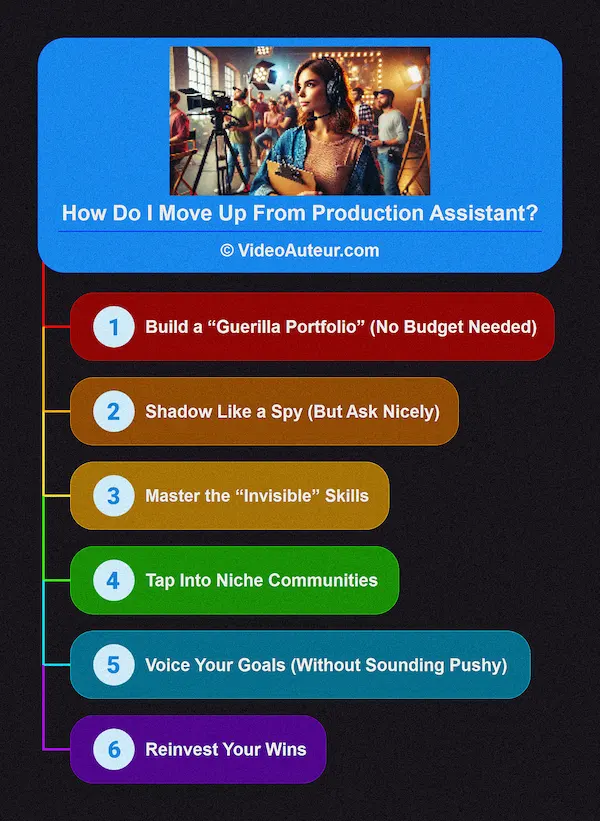 "How do I move up from Production Assistant?", you say? Here are some practical steps to build your video career.
"How do I move up from Production Assistant?", you say? Here are some practical steps to build your video career.1. Build a “Guerilla Portfolio” (No Budget Needed)
You don’t need a Hollywood project to showcase your skills. Start small:
Film three 1-minute videos:
- A montage (example, a day in your city, using dynamic angles and music).
- A mini-interview (ask a friend about their passion project).
- An event clip (capture energy at a local market or park).
Use whatever you have: Shoot on your phone or any camera, edit with free tools like DaVinci Resolve, and lean into natural light.
Pro tip: Add a 10-second “process” clip at the end—show yourself setting up a shot or troubleshooting sound. It proves you’re thinking, not just filming.
2. Shadow Like a Spy (But Ask Nicely)
Most crews love sharing their craft—if you ask with genuine curiosity:
- Target a role you’re curious about: “Hey [Editor’s Name], I’d love to see how you approach color grading. Could I shadow you for 20 minutes during lunch?”
- Bring coffee or snacks: A small gesture goes a long way.
- Take notes discreetly: Jot down shortcuts, workflow hacks, or gear recommendations.
3. Master the “Invisible” Skills
Moving up isn’t only about technical chops. It’s about reliability:
- File organization: Practice naming footage clearly—for example, “Wedding_Speech_Jason_CloseUp”.
- Prep speed: Time yourself setting up a tripod or coiling cables. Efficiency = trust.
- Problem-solving: When something goes wrong (and it will!), practice saying, “I’ll figure it out,” instead of “I don’t know.”
4. Tap Into Niche Communities
The right tribe will accelerate your growth:
- Join Facebook groups: Find spaces to learn from. These groups have practitioners or pros who’ve been in your shoes.
- Follow Instagram accounts: Follow accounts for quick tips.
- Attend free workshops: Local film schools or libraries often host guest speakers.
5. Voice Your Goals (Without Sounding Pushy)
Most PAs stay stuck because they’re afraid to speak up. Try this:
- Casual conversations: “I’d love to learn more about [lighting/editing/etc.]. Any advice for someone starting out?”
- After wrapping a tough day: “I really admired how you handled [specific task]. Would you mind if I helped with something like that next time?”
6. Reinvest Your Wins
Land a side gig editing a friend’s podcast? Use the cash to:
- Rent a prime lens for a weekend.
- Buy a used audio recorder.
- Take an online class on storytelling frameworks.
Remember: It's better to move forward than to aim for flawless.
Your first projects don’t need polish. They just need to prove you’re willing to try, learn, and put yourself out there. The DP who hires you isn’t looking for perfection—they’re looking for someone who’ll show up, adapt, and care as much as they do.
Your path won’t look like anyone else’s, and that’s okay. Start where you are, use what you have, and treat every “small” task as a chance to learn. The crew members hiring for bigger roles? They’re looking for someone who cares deeply, not someone with the fanciest reel.
You’ve already got the hardest part down: showing up. Now, it’s time to let your curiosity lead the way.
Conclusion - "How do I move up from Production Assistant?"
Here’s a secret you might not have heard of: Your time as a PA is a paid apprenticeship. Every coffee run, every cable coiled, every moment you spend quietly observing a live set—it’s all fuel for your next chapter.
Moving up isn’t about waiting for a promotion or a lucky break. It’s about noticing the unnoticed. The DP adjusting a light stand, the editor muttering about pacing, the producer calming a frantic client—these are all clues to the skills you’ll need.
Your journey might start with borrowing a phone tripod to film your friend’s art project, or staying late to help the sound team pack up (and asking one curious question about their gear).
The path won’t be straight. You’ll film shaky clips, fumble through edits, and maybe even crash a drone into a bush (we’ve all been there). But here’s what matters: You keep showing up.
So, what’s your first step?
- Today: Film one 30-second clip of something ordinary—steam rising from your coffee, rain hitting a window. Practice finding beauty in the mundane.
- This week: Ask to shadow someone for 15 minutes. Bring a notebook, not your phone.
- This month: Share your roughest, most honest work with one person who inspires you. Say, “I’d love your thoughts.”
The videographer you admire? They started exactly where you are—holding a spare battery, wondering if they’d ever get to call the shots.
Your turn.
P.S. Think about the last time you solved a problem on set. However small, that’s proof: You’re not just a PA. You’re a storyteller in training. Now go film something only you would think to capture.









